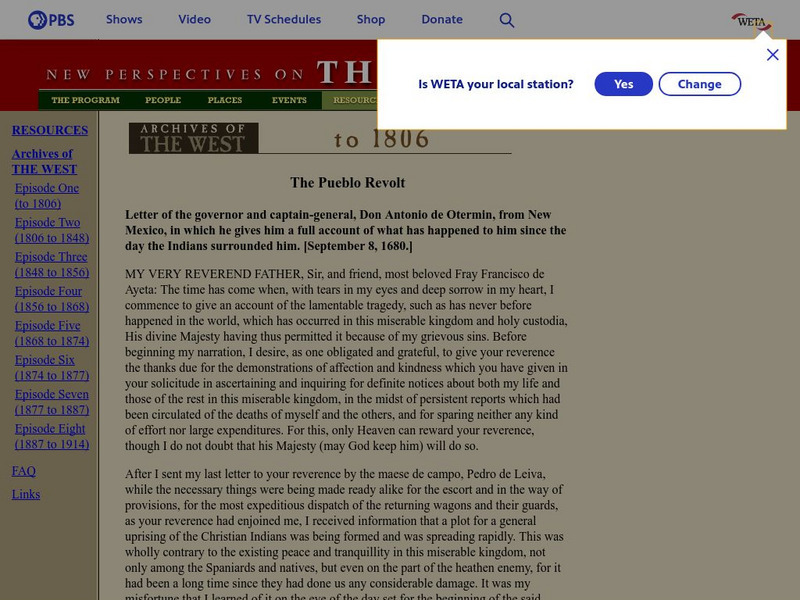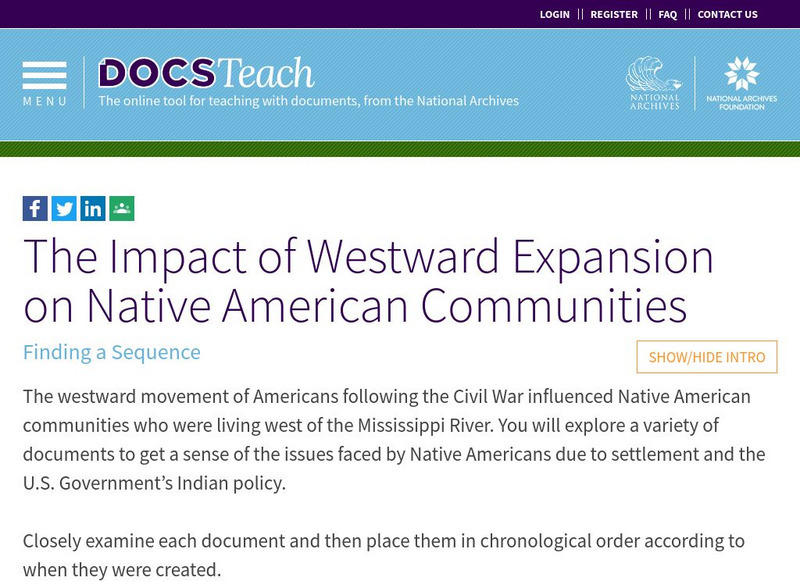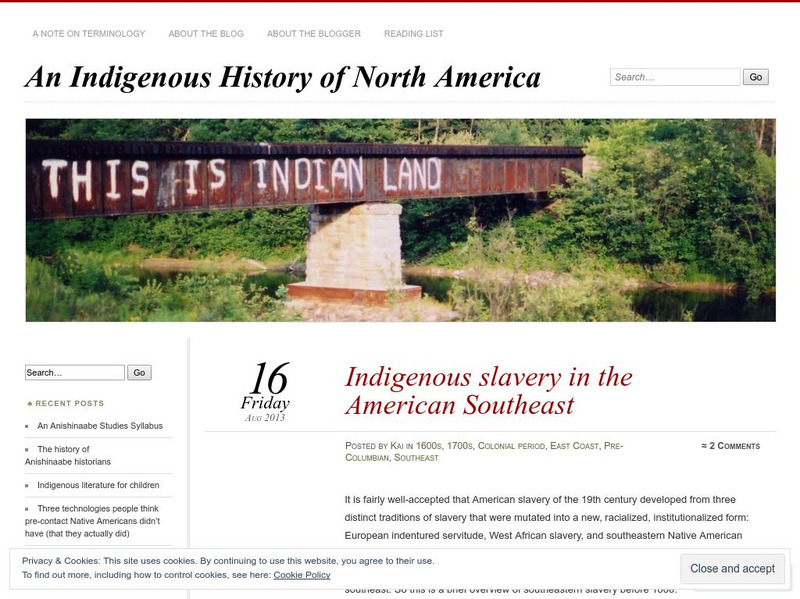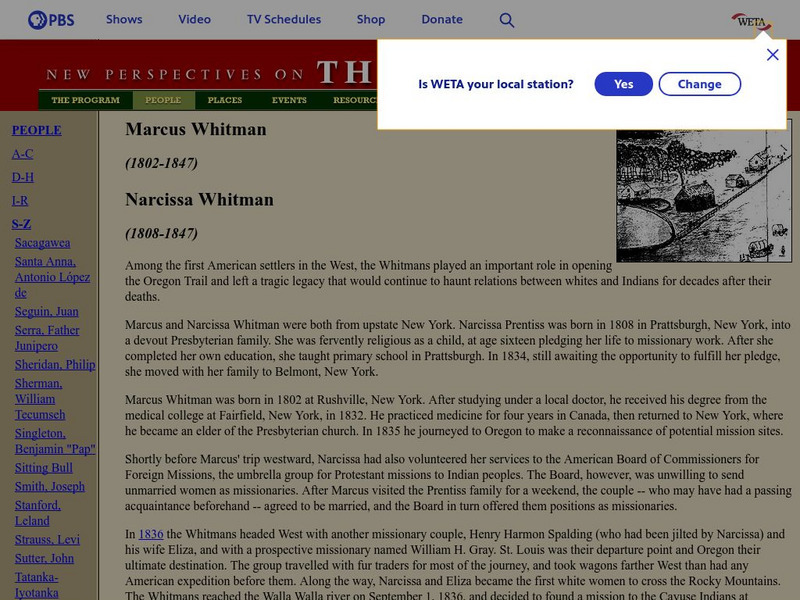University of Groningen
American History: Outlines: Colonial Indian Relations
By 1640 the British had solid colonies established along the New England coast and the Chesapeake Bay. In between were the Dutch and the tiny Swedish community. To the west were the original Americans, the Indians.
OpenStax
Open Stax: The Loss of American Indian Life and Culture
Read this section from a chapter on "Westward Expansion" to learn about the methods that the U.S. government used to address the "Indian threat" during the settlement of the West and explain the process of "Americanization" as it applied...
University of Groningen
American History: Outlines: Colonial Indian Relations
By 1640 the British had solid colonies established along the New England coast and the Chesapeake Bay. In between were the Dutch and the tiny Swedish community. To the west were the original Americans, then called Indians.
PBS
Pbs: New Perspectives on the West: Journey of Alvar Nunez Cabeza De Vaca
Read the incredible story of Cabeza de Vaca in his own words. He tells of his many years-long journey across the South, and writes as an ethnologist about the Native Americans he encounters. A fascinating account!
Library of Congress
Loc: Teachers: Journeys West
A series of lessons utilizing primary texts, including narratives, photographs, and maps, through which students explore the following question: "What motivated thousands of people to journey west during the 1800s?"
PBS
New Perspectives on the West: The Pueblo Revolt
From the PBS series "The West," comes this letter from Don Antonio de Otermin, the governor of New Mexico during the Pueblo Revolt of 1680. This unique first hand account does come with a certain amount of bias, as it was written by one...
University of Groningen
American History: Essays: Failure of West Indian Company Farming
Chronicles the begining of company farming in the United States and what led to its faliure. Click on "next" at the bottom of each page to get more of this essay. In-depth information.
PBS
Pbs the West: Sacagawea
Part of a comprehensive site on the American West, this page explains Sacagawea's legendary role in the Lewis and Clark expedition.
University of Groningen
American History: Outlines: The Witches of Salem
In 1692 a group of adolescent girls in Salem Village, Massachusetts, became subject to strange fits after hearing tales told by a West Indian slave. When they were questioned, they accused several women of being witches who were...
PBS
Pbs the West: The Nez Perce and the Dawes Act
This companion article from the PBS series, "New Perspectives on the West," offers a lesson plan which approaches the Dawes Act from the perspective of the Nez Perce.
Smithsonian Institution
Smithsonian American Art Museum: George Catlin's Indian Gallery
The Smithsonian offers 32 of Catlin's Indian Gallery paintings online. Catlin visited 50 tribes living west of the Mississippi from 1830 to 1836.
PBS
Pbs Archives of the West: Dawes Act
The text of the famous Dawes Act of 1887 which attempted to provide allotment of lands to Native Americans.
Carnegie Museum of Natural History
Carnegie Museum: North South East West: American Indians and the Natural World
Web companion site to the Alcoa Foundation Hall of American Indians exhibit at the Carnegie Museum of Natural History. It focuses on American Indians' relationships with the natural world and explores four different visions: the Tlingit...
US National Archives
Docsteach: The Impact of Westward Expansion on Native American Groups
In this activity, students will examine the impact of westward expansion and settlement on Native American groups following the Civil War. Students will explore a variety of documents to get a sense of the issues faced by Native...
Other
Indigenous History: Indigenous Slavery in the American Southeast
It is fairly well-accepted that American slavery of the 19th century developed from three distinct traditions of slavery that were mutated into a new, racialized, institutionalized form: European indentured servitude, West African...
Other
Colorado Historical Society: Kit Carson: A Hero in Fact and Fiction [Pdf]
A short biography of the legend of the West, Kit Carson. PDF (requires Adobe Reader).
PBS
Pbs: Archives of the West: Selections From "With the Nez Perces"
Contains selections from "With the Nez Perces: Alice Fletcher in the Field, 1889-92" by E. Jane Gay, which provided an anthropological look at the Nez Perce Indians and their bewilderment at the Dawes Act.
PBS
Pbs: Indian Territory
This site from PBS provides a short description and map of "the Indian Territory set aside by the Indian Removal Act of 1830 and the areas designated for each tribe."
PBS
Pbs the West: Fight No More Forever (1874 1877)
From the PBS critically acclaimed series, "The West" comes this introduction to the Indian Wars that were waged in the course of settling the frontier.
PBS
The West Project: John M. Chivington (1821 1894)
This is a biography of the controversial and brutal general of the American Civil War John M. Chivington who is remembered for the Sand Creek Massacre of some 200 unarmed Indian women and children.
Other
West Virginia University: A Summary of Native American Religions
This is an excellent introduction to Native American religious beliefs and practices. Includes an explanation of the major Native American Religions and their history. Site is extensive and exclusively text-based.
PBS
Wnet: Thirteen: Whose Land Is This? Conflict Between Native Americans & Settlers [Pdf]
A lesson plan from the producers of the 16-episode PBS series "Freedom: A History of US" designed to provide insights into the causes of the conflict between Native Americans and new settlers pushing west. Students will examine official...
PBS
New Perspectives on the West: Marcus Whitman & Narcissa Whitman
PBS site detailing the Whitmans' journey to Oregon country, their establishment of a mission, and their death at the hands of the Indians. Also includes some background information.
PBS
Pbs the West: A Wound in the Heart
As many as three million buffalo were killed in two years after the coming of the railroad. This site tells the story through quotes from one of the hunters and from Native American writer Scott Momaday and others.





















